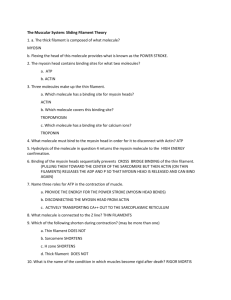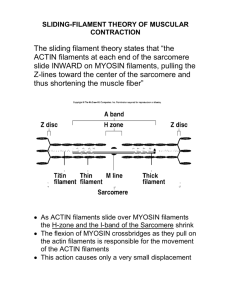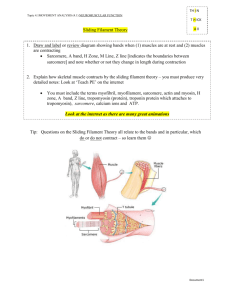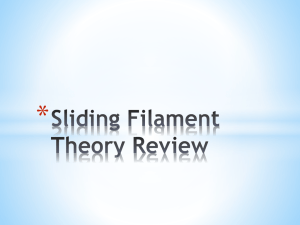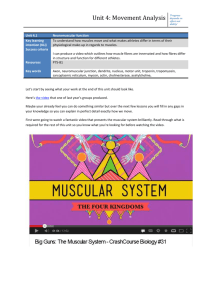Sliding Filament Theory: Muscle Contraction Worksheet
advertisement
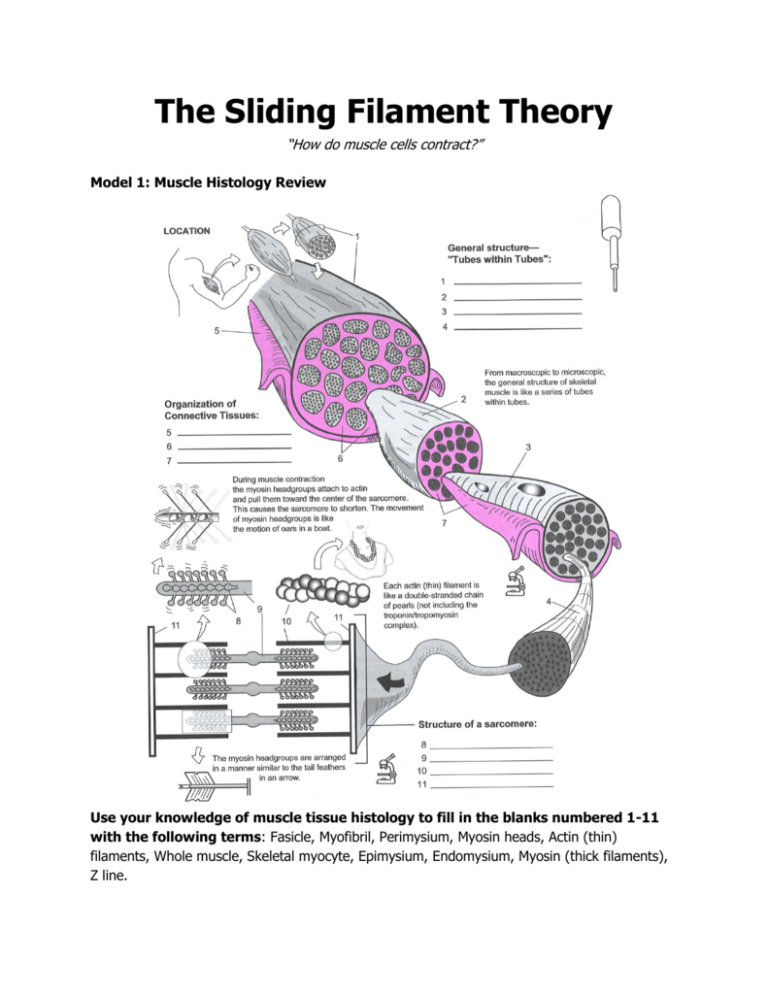
The Sliding Filament Theory “How do muscle cells contract?” Model 1: Muscle Histology Review Use your knowledge of muscle tissue histology to fill in the blanks numbered 1-11 with the following terms: Fasicle, Myofibril, Perimysium, Myosin heads, Actin (thin) filaments, Whole muscle, Skeletal myocyte, Epimysium, Endomysium, Myosin (thick filaments), Z line. Model 2: Muscle contraction takes place at the level of the sarcomere. Critical Thinking Questions 1. What structural component of the sarcomere is associated with arrows in model 2? 2. Based on this, which component of the sarcomere is actually being moved when the sarcomere contracts and relaxes? 3. Which component of the sarcomere is physically attached to the structure that gets moved (i.e. the answer to question 2)? 4. What component of the sarcomere is NOT directly attached to the Z-line? 5. Based on your answer to question 4, what component of the sarcomere is pulling on the thin filaments to bring the Z-lines closer together? Application 6. In the space below, write a short description as a group that explains the role of the think filaments, thick filaments, and Z-line in sarcomere contraction. Thin filament: Thick Filament: Z-line: Model 3: Molecular events of the contraction cycle Critical Thinking Questions 7. Find the thin filament in part 1 of model 3 (attachment) and draw a bracket and label it ‘thin filament’. 8. Which component of the thin filament (which isn’t labeled in this model) makes the main ‘string-of-pearls’ portion of the filament? a. in the space below, list the other molecules that are found in/on the thin filament. 9. The myosin head is bound to some other molecules, what are they? a. To which specific region of actin is the myosin head bound? 10. In your own words, describe the change that occurs in the myosin molecule between stage 1 (attachment) and stage 2 (pulling). a. Circle the two places where the myosin molecule bends in this stage on part 2 of the model. 11. The myosin head doesn’t release from the actin binding site until a new molecule enters the cycle. According to the model, what molecule allows myosin to release from actin? 12. In stage 4 of this cycle, the myosin molecule moves back into the cocked position. Where does it get the energy to re-cock itself? 13. Look at all the myosin binding sites on the actin filament. Does it appear that each site lines up perfectly with a myosin head? a. Myosin can only bind to a binding site that is at the tip of a helix in the actin filament (like the one in phase 1 of the model). After the power stroke (pulling phase) and detachment is the myosin head lined up with a binding site at the tip of the filament? b. Can this particular myosin head bind to the actin filament for the next stroke? c. Look at the feet of these children. Are they all able to pull at exactly the same time? d. As a group, explain how myosin pulling on actin works kind of like kids playing tug-ofwar. Model 4: Effects of calcium on the thin filament 14. Look at the left half of the model. Is calcium present here? a. Is the myosin binding site of actin exposed so that myosin can actually bind to it? b. What is blocking myosin’s access to the binding site on actin? 15. Now look at the right side of the model. Is calcium present here? a. To what molecule did it bind? b. What changed about the troponin molecule after it bound calcium? (hint look at the little orange calcium binding site on troponin) c. What effect did this change in troponin have on tropomyosin? d. Is the myosin binding site of actin exposed when calcium is present? 16. In the space below, write a grammatically correct sentence (in English) that explains the role of troponin, tropomyosin, and calcium in muscle cell contraction. Application 17. What would happen to a muscle cell in either of the following situations? a. The cell runs out of ATP b. There is an excess amount of calcium in the cell. Model 5: Neuromuscular junction 18. Can muscles contract if there isn’t any free calcium in the cell? a. According to model 5, where is calcium stored inside a muscle cell? b. What causes the calcium to be released from where it is stored? 19. What chemical messenger transmits the electrical impulse between the nerve cell and the muscle cell? Application 20. Acetylcholine esterase is an enzyme that degrades Ach in the neuromuscular junction. The nerve gas Sarin blocks this enzyme causing Ach to remain available for binding to the muscle cell receptors. What effect would Sarin gas have on the muscles of your body? As a group, explain why Sarin gas is a deadly poison. [hint: your diaphragm is a muscle] Exercises 1. Use models 5, 4, 3, 2, and 1 to put the following events in order from the signal from the brain reaching a muscle to the contraction of the whole muscle. Myosin bends in two places, releasing ADP and pulling on the thin filament The nerve impulse reaches the end of the nerve and causes it to release acetylcholine (Ach) An electrical impulse travels down a nerve fiber The Z-lines are pulled closer together and the A-band shrinks Ach binds to receptors on the muscle cell membrane and causes the electrical impulse to be transmitted to the muscle cell Calcium ions bind to troponin causing it to rotate The myofibril gets shorter (contracts) The electrical impulse inside the muscle cell causes the release of calcium ions from the endoplasmic reticulum Rotation of troponin move tropomyosin off of the myosin binding site on actin The myosin head binds the myosin binding domain of actin

